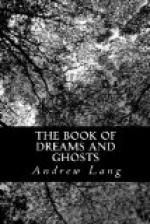Douch makes the warning arrive “some few days” before the murder of Buckingham, and says that the ghost of Sir George, “in his morning gown,” bade one Parker tell Buckingham to abandon the expedition to La Rochelle or expect to be murdered. On the third time of appearing the vision pulled a long knife from under his gown, as a sign of the death awaiting Buckingham. He also communicated a “private token” to Parker, the “percipient,” Sir George’s old servant. On each occasion of the appearance, Parker was reading at midnight. Parker, after the murder, told one Ceeley, who told it to a clergyman, who told Douch, who told Glanvil.
In Lilly’s version the ghost had a habit of walking in Parker’s room, and finally bade him tell Buckingham to abstain from certain company, “or else he will come to destruction, and that suddenly”. Parker, thinking he had dreamed, did nothing; the ghost reappeared, and communicated a secret “which he (Buckingham) knows that none in the world ever knew but myself and he”. The duke, on hearing the story from Parker, backed by the secret, was amazed, but did not alter his conduct. On the third time the spectre produced the knife, but at this information the duke only laughed. Six weeks later he was stabbed. Douch makes the whole affair pass immediately before the assassination. “And Mr. Parker died soon after,” as the ghost had foretold to him.
Finally, Clarendon makes the appearances set in six months before Felton slew the duke. The percipient, unnamed, was in bed. The narrative now develops new features; the token given on the ghost’s third coming obviously concerns Buckingham’s mother, the Countess, the “one person more” who knew the secret communicated. The ghost produces no knife from under his gown; no warning of Buckingham’s death by violence is mentioned. A note in the MS. avers that Clarendon himself had papers bearing on the subject, and that he got his information from Sir Ralph Freeman (who introduced the unnamed percipient to the duke), and from some of Buckingham’s servants, “who were informed of much of it before the murder of the duke”. Clarendon adds that, in general, “no man looked on relations of that sort with less reverence and consideration” than he did. This anecdote he selects out of “many stories scattered abroad at the time” as “upon a better foundation of credit”. The percipient was an officer in the king’s wardrobe at Windsor, “of a good reputation for honesty and discretion,” and aged about fifty. He was bred at a school in Sir George’s parish, and as a boy was kindly treated by Sir George, “whom afterwards he never saw”. On first beholding the spectre in his room, the seer recognised Sir George’s costume, then antiquated. At last the seer went to Sir Ralph Freeman, who introduced him to the duke on a hunting morning at Lambeth Bridge. They talked earnestly apart, observed by Sir Ralph, Clarendon’s informant. The duke seemed abstracted all day;




